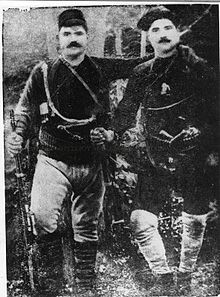Michael Sionidis
Kapetan (Chieftain) Michael Sionidis | |
|---|---|
 Michael Sionidis and his cousin, Dionysius Sionidis during the Macedonian Struggle.[a] | |
| Native name | Μιχαήλ Σιωνίδης |
| Born | c. 1870 Grčište, Salonika Vilayet, Ottoman Empire (now Republic of North Macedonia). |
| Died | c. 1935 Evzonoi, Kingdom of Greece |
| Allegiance | |
| Service/ | |
| Unit | III Army Corps |
| Battles/wars | Macedonian Struggle Balkan Wars |
| Awards | Commemorative Medal of the Macedonian Struggle |
Michael Sionidis (Greek: Μιχαήλ Σιωνίδης or Μιχάλης Σιωνίδης, Mihális Sionídis; c. 1870–1935) was a Greek leader of makedonomachoi in the Macedonian Struggle.
Early life[edit]
Michael Sionidis was born in the village of Grčište,[citation needed] Ottoman Empire (near Bogdanci in the present-day North Macedonia) in about 1870.
Military career[edit]
At the outbreak of the Macedonian Struggle in 1904, Sionidis fought against the pro-Bulgarian komitadjis,[b] acting in an area covering Grčište, Gevgelija and Doirani. Sionidis first fought under Georgios Zira,[c] then under Emmanuel Katsigaris,[d] before he finally founded his own militia.[2]
In the autumn of 1904, Bulgarian komitadjis killed several of Grčište's Greek inhabitants, including the teacher Catherine Hadjigeorgiou, who was Michael's cousin, the teacher Constantine Sionidis, Andronikis' daughter, and five other Greeks. In retaliation, Sionidis led his militia in an attack on the village of Marvinci, where the komitadjis were hiding.[2] After getting injured, he went to Gevgelija to recuperate (January 1905).[3]
After the First Balkan War, Grčište came under Serbian control, and Sionidis moved to the village of Matsikovo (modern Evzonoi), which was at the time on the Greco-Serbian border. During the Balkan Wars, King Constantine I of Greece established his headquarters in his house. Sionidis participated in the Battle of Kilkis-Lahanas, where he was injured. Sionidis also participated in the Battle of Skra-di-Legen during World War I, and worked as a secret agent of the Third Army Corps behind enemy lines, in the area of Strumica.[3]
Later years[edit]
Following the end of World War I, Sionidis, as president of Matsikovo community, retrieved the remains of nine evzones whom the Bulgarians had killed during the Second Balkan War, and buried them in his village. In 1927, the Epitropi Metonomasias[e] renamed Matsikovo to Evzonoi in their honour. Michael Sionidis died in 1935.[3]
For his services, he was awarded the Golden Cross of Valour, Greece's highest bravery award, along with the War Cross and the Commemorative Medal of the Macedonian Struggle.[3]
Notes[edit]
- ^ "The pair are dressed in pants of woolen material, waistcoats and wear the caps of makedonomachoi. In addition they wear homespun stockings. The figure at left wears tsarouhia without pompons, and the right wears service boots. The figure at left wears a square silver amulet with a skull and crossbones suspended over his chest. They each carry a Fusil Gras mle 1874. They wear their cartridges in their belts. The left wears a double-edge kama knife in his belt while the right has a knife and a Gasser M1870 Montenegrin Pattern revolver."[1]
- ^ "Committee members", i.e. members of cheta bands sympathising with the Internal Macedonian Revolutionary Organization
- ^ Γεώργιος Ζήρα
- ^ Εμμανουήλ Κατσίγαρης
- ^ "Committee for Name Change", see Geographical name changes in Greece
References[edit]
- ^ "Photographic Archive". imma.edu.gr (in Greek). Ὶδρυμα Μουσείο Μακεδονικού Αγώνα [Museum of the Macedonia Struggle Foundation].
- ^ a b Vacalopoulos, Constantin Ap. (1979). "Anékdoto mitróo ton makhitón tou Makedonikoú Agóna" Ανέκδοτο μητρώο των μαχητών του Μακεδονικού Αγώνα (PDF). Μακεδονικά (in Greek). 19: 40–92. doi:10.12681/makedonika.451.
- ^ a b c d Η Ελληνικη Αντισταση στη Μακεδονια 1904-1908 [The Greek Resistance in Macedonia 1904–1908]. Imathías Laós (in Greek). 14 October 2007. Archived from the original on 21 January 2008. Retrieved 23 January 2016.
Further reading[edit]
- Ιστορία νεότερη και σύγχρονη Γ' Λυκείου [History new and modern Third Class Senior Highschool] (in Greek). Athens: OEDB. 2002.
- Papyrus Larousse Britannica. Vol. 5.
{{cite encyclopedia}}: Missing or empty|title=(help) - Ιστορία του Νέου Ελληνισμού [History of New Hellenism] (in Greek). Vol. 5. Athens: Ellinika Grammata.
- 1870s births
- 1935 deaths
- People from Valandovo Municipality
- Eastern Orthodox Christians from Greece
- Macedonian revolutionaries (Greek)
- People of the Macedonian Struggle
- Macedonia under the Ottoman Empire
- Greek people of the Balkan Wars
- Greek people of World War I
- Recipients of the War Cross (Greece)
- Recipients of the Cross of Valour (Greece)
- Greeks from the Ottoman Empire
- Greek Macedonians

